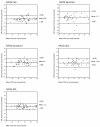Validation of the Rheumatoid and Arthritis Outcome Score (RAOS) for the lower extremity
- PMID: 14613567
- PMCID: PMC280699
- DOI: 10.1186/1477-7525-1-55
Validation of the Rheumatoid and Arthritis Outcome Score (RAOS) for the lower extremity
Abstract
Background: Patients with inflammatory joint diseases tend due to new treatments to be more physically active; something not taken into account by currently used outcome measures. The Rheumatoid and Arthritis Outcome Score (RAOS) is an adaptation of the Knee injury and Osteoarthritis Outcome Score (KOOS) and evaluates functional limitations of importance to physically active people with inflammatory joint diseases and problems from the lower extremities. The aim of the study was to test the RAOS for validity, reliability and responsiveness.
Methods: 119 in-patients with inflammatory joint disease (51% RA) admitted to multidisciplinary care, mean age 56 (+/-13), 73% women, mean disease duration 18 (+/-14) yr were consecutively enrolled. They all received the RAOS, the SF-36, the HAQ and four subscales of the AIMS2 twice during their stay for test of validity and responsiveness. Test-retest reliability of the RAOS questionnaire was calculated on 52 patients using the first or second administration and an additional mailed questionnaire.
Results: The RAOS met set criteria of reliability and validity. The random intraclass correlation coefficient (ICC 2,1) for the five subscales ranged from 0.76 to 0.92, indicating that individual comparisons were possible except for the subscale Sport and Recreation Function. Inter-item correlation measured by Cronbach's alpha ranged from 0.78 to 0.95. When measuring construct validity the highest correlations occurred between subscales intended to measure similar constructs. Change over time (24 (+/- 7) days) due to multidisciplinary care was significant for all subscales (p < 0.001). The effect sizes ranged from 0.30-0.44 and were considered small to medium. All the RAOS subscales were more responsive than the HAQ. Some of the SF-36 subscales and the AIMS2 subscales were more responsive than the RAOS subscales.
Conclusion: It is possible to adapt already existing outcome measures to assess other groups with musculoskeletal difficulties in the lower extremity. The RAOS is a reliable, valid and responsive outcome instrument for assessment of multidisciplinary care. To fully validate the RAOS further studies are needed in other populations.
Figures



Similar articles
-
Knee injury and Osteoarthritis Outcome Score (KOOS) - validation and comparison to the WOMAC in total knee replacement.Health Qual Life Outcomes. 2003 May 25;1:17. doi: 10.1186/1477-7525-1-17. Health Qual Life Outcomes. 2003. PMID: 12801417 Free PMC article.
-
Evaluation and cultural adaptation of a German version of the AIMS2-SF questionnaire (German AIMS2-SF).Rheumatology (Oxford). 2005 Sep;44(9):1190-5. doi: 10.1093/rheumatology/keh718. Epub 2005 Jun 21. Rheumatology (Oxford). 2005. PMID: 15972355
-
[Evaluating the reliability, validity and responsiveness of the german short musculoskeletal function assessment questionnaire, SMFA-D, in inpatient rehabilitation of patients with conservative treatment for hip osteoarthritis].Rehabilitation (Stuttg). 2004 Aug;43(4):233-40. doi: 10.1055/s-2004-828294. Rehabilitation (Stuttg). 2004. PMID: 15318291 Clinical Trial. German.
-
The Knee injury and Osteoarthritis Outcome Score (KOOS): from joint injury to osteoarthritis.Health Qual Life Outcomes. 2003 Nov 3;1:64. doi: 10.1186/1477-7525-1-64. Health Qual Life Outcomes. 2003. PMID: 14613558 Free PMC article. Review.
-
A primer on lower extremity outcome measurement instruments.Iowa Orthop J. 1998;18:101-11. Iowa Orthop J. 1998. PMID: 9807715 Free PMC article. Review.
Cited by
-
Selecting patient-reported outcome measures of health-related quality of life in adult rheumatology: quality and breadth of coverage.Rheumatol Int. 2023 Apr;43(4):627-638. doi: 10.1007/s00296-022-05200-6. Epub 2022 Sep 20. Rheumatol Int. 2023. PMID: 36125521 Review.
-
An update on joint-specific outcome measures in total hip replacement.Reumatologia. 2020;58(2):107-115. doi: 10.5114/reum.2020.95366. Epub 2020 Apr 30. Reumatologia. 2020. PMID: 32476684 Free PMC article. Review.
-
Generalized joint hypermobility in childhood is a possible risk for the development of joint pain in adolescence: a cohort study.BMC Pediatr. 2014 Dec 10;14:302. doi: 10.1186/s12887-014-0302-7. BMC Pediatr. 2014. PMID: 25492414 Free PMC article.
-
"Blue flags", development of a short clinical questionnaire on work-related psychosocial risk factors - a validation study in primary care.BMC Musculoskelet Disord. 2017 Jul 24;18(1):318. doi: 10.1186/s12891-017-1677-z. BMC Musculoskelet Disord. 2017. PMID: 28738803 Free PMC article. Clinical Trial.
-
Knee osteoarthritis related pain: a narrative review of diagnosis and treatment.Int J Health Sci (Qassim). 2014 Jan;8(1):85-104. doi: 10.12816/0006075. Int J Health Sci (Qassim). 2014. PMID: 24899883 Free PMC article. Review.
References
-
- Benedek Thomas G. History of the Rheumatic Diseases. In: John H Klippel, editor. Primer on the Rheumatic Diseases. 11. Atlanta, Georgia, Arthritis Foundation; 1997.
-
- Pincus T, Ferraccioli G, Sokka T, Larsen A, Rau R, Kushner I, Wolfe F. Evidence from clinical trials and long-term observational studies that disease-modifying anti-rheumatic drugs slow radiographic progression in rheumatoid arthritis: updating a 1983 review. Rheumatology (Oxford) 2002;41:1346–1356. doi: 10.1093/rheumatology/41.12.1346. - DOI - PubMed
-
- Guillemin F. Functional disability and quality-of-life assessment in clinical practice. Rheumatology (Oxford) 2000;39 Suppl 1:17–23. - PubMed
Publication types
MeSH terms
LinkOut - more resources
Full Text Sources
Other Literature Sources
Medical
Miscellaneous

